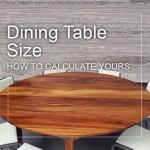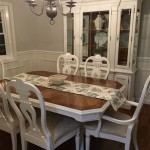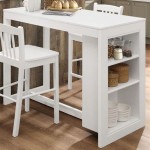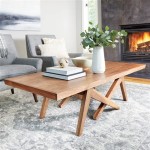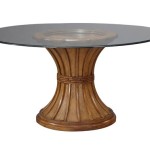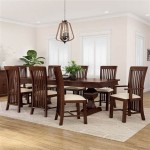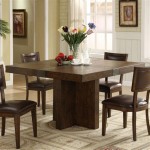The Expanding Horizons of Dining: Dining Room Tables That Extend To Seat 12
The modern dining room table has evolved beyond its basic function as a surface for eating. It now represents a central gathering point for families and friends, a space for celebrations, discussions, and shared experiences. As social circles grow and the need to accommodate larger gatherings arises, the demand for dining room tables that can extend to seat 12 has increased significantly. These tables offer the flexibility to comfortably host sizable dinner parties or family reunions without permanently occupying an excessive amount of floor space when not needed.
Choosing the right extendable dining table involves careful consideration of several factors, including the available space, desired aesthetic, budget, and frequency of large gatherings. A well-selected extending table can enhance both the functionality and visual appeal of a dining area, offering a practical solution for accommodating varying numbers of guests.
Understanding the Mechanics of Extension: Types of Extendable Dining Tables
Extendable dining tables come in various designs, each with its unique mechanism for expanding and contracting the table surface. Understanding these different mechanisms is crucial in selecting a table that best suits individual needs and preferences.
One common type utilizes leaves that are stored separately and inserted into the table when needed. These leaves are typically made of the same material and finish as the main table, ensuring a cohesive appearance when fully extended. The table usually features a split in the center, allowing the two halves to be pulled apart, creating space for the leaf or leaves to be inserted. The leaves are then secured in place, creating a larger, continuous surface.
Another type employs self-storing leaves, which are integrated within the table itself. This design eliminates the need to store leaves separately, streamlining the extension process. These leaves can be folded or slid out from beneath the main table surface, providing a convenient and space-saving solution. Butterfly leaf mechanisms are a common example, where the leaf folds in half and tucks away neatly under the tabletop.
Drop-leaf tables offer a different approach to extension. These tables feature hinged leaves that can be raised or lowered to expand or reduce the table surface. When not in use, the leaves are folded down, creating a smaller, more compact table. Drop-leaf tables are often used in smaller dining areas where space is limited.
A less common but increasingly popular design involves a series of interlocking sections that slide or fold out to create a larger table. This type often boasts a more contemporary aesthetic and can offer a seamless transition between the smaller and larger configurations.
The choice of extension mechanism depends on factors such as ease of use, storage requirements, and aesthetic preferences. Selecting a mechanism that is both functional and visually appealing is paramount for long-term satisfaction.
Material Considerations: Durability, Aesthetics, and Maintenance
The material used in the construction of an extendable dining table significantly impacts its durability, aesthetic appeal, and maintenance requirements. Common materials include wood, metal, glass, and laminate, each offering distinct advantages and disadvantages.
Wood, particularly hardwoods like oak, maple, and walnut, is a popular choice for dining tables due to its inherent strength, natural beauty, and versatility. Wooden tables can be stained or painted to match a variety of décor styles, and they are generally durable and long-lasting. However, wood is susceptible to scratches, dents, and water damage, requiring regular maintenance and care.
Metal, such as stainless steel or wrought iron, offers a modern and industrial aesthetic. Metal tables are typically very durable and resistant to damage, making them a suitable option for high-traffic areas or households with children. However, metal can be cold to the touch and may not complement all décor styles. Furthermore, some metal finishes can be prone to scratches or fingerprints.
Glass tabletops offer a sleek and contemporary look. They are easy to clean and maintain, and they can create a sense of spaciousness in a dining area. However, glass is fragile and can be prone to scratches and shattering. Tempered glass is a safer option, as it is more resistant to breakage. Glass tables also often require additional support structures, such as metal or wood frames, to ensure stability.
Laminate surfaces provide a cost-effective alternative to solid wood. Laminate tables are durable, easy to clean, and resistant to scratches and stains. They are available in a wide range of colors and patterns, mimicking the look of wood, stone, or other materials. However, laminate can lack the warmth and character of natural wood, and it may not be as durable in the long run.
The selection of the table material should consider factors such as budget, aesthetic preferences, and the level of maintenance required. Choosing a material that balances durability, beauty, and practicality is essential for a satisfying purchase.
Size and Space Planning: Optimizing the Dining Area for Comfort and Functionality
Before purchasing an extendable dining table that seats 12, it is crucial to accurately measure the dining area and consider the space required for comfortable seating and movement. Insufficient space can lead to overcrowding and impede the functionality of the dining area.
A general guideline is to allow at least 36 inches of space between the edge of the table and any walls or furniture. This allows for comfortable chair movement and ample room for people to walk around the table. For larger gatherings, it may be necessary to increase this space to 48 inches or more.
Consider the dimensions of the table both in its compact and extended configurations. Ensure that the extended table will fit comfortably within the dining area, leaving sufficient space for seating and movement. It is also essential to consider the shape of the table. Rectangular tables are often the most efficient for seating multiple people, but round or oval tables can create a more intimate and conversational atmosphere.
The size and style of the chairs also play a crucial role in space planning. Choose chairs that are appropriately sized for the table and provide comfortable seating. Avoid chairs that are too bulky or have wide armrests, as they can take up valuable space. Consider stacking or folding chairs for additional seating options when the table is fully extended.
Lighting is another important factor to consider. Ensure that the dining area is adequately lit, with a combination of ambient, task, and accent lighting. A chandelier or pendant light above the table can create a focal point and provide ample illumination for dining. Wall sconces or recessed lighting can provide additional ambient light, while task lighting can be used to highlight specific areas of the room.
Proper space planning is essential for creating a dining area that is both functional and aesthetically pleasing. Taking the time to carefully measure the space and consider the dimensions of the table, chairs, and other furniture will ensure that the dining area is comfortable and inviting for all occasions.
Design and Style: Harmonizing the Table with Existing Décor
The design and style of the extendable dining table should complement the existing décor of the dining room. The table should integrate seamlessly with the overall aesthetic, enhancing the visual appeal of the space.
Consider the style of the room, whether it is traditional, modern, contemporary, or eclectic. A traditional dining room might benefit from a classic wooden table with ornate details, while a modern dining room might call for a sleek glass or metal table with clean lines. A contemporary dining room could accommodate a table with a unique and innovative design.
The color and finish of the table should also complement the existing color palette of the room. Neutral colors, such as white, gray, or beige, are versatile and can be easily incorporated into a variety of décor styles. Warm wood tones can add warmth and character to a dining room, while cool metal finishes can create a more contemporary look.
The shape of the table can also influence the overall aesthetic of the dining room. Rectangular tables are often the most formal and traditional, while round or oval tables can create a more intimate and conversational atmosphere. Square tables are a good option for smaller dining areas.
The details of the table, such as the legs, apron, and edge, can also contribute to its overall style. Ornate legs and aprons can add a touch of elegance to a traditional table, while simple, clean lines can create a more modern look. The edge of the table can be straight, rounded, or beveled, each offering a different aesthetic appeal.
Incorporating personal touches, such as a decorative centerpiece or a collection of interesting objects, can further enhance the style of the dining room and make it feel more inviting. Choosing a table that reflects individual style and preferences is essential for creating a dining area that is both functional and aesthetically pleasing.
Selecting an extendable dining table that seats 12 requires a thorough assessment of space constraints, material preferences, extension mechanisms, and desired aesthetic. A well-chosen table will not only provide ample seating for large gatherings but will also enhance the overall ambience of the dining room, becoming a cherished centerpiece for years to come.

12 Seater Extending Dining Table Wooden Oak Ceramic

Junior Giant Console Extending Table Transformer Seats 12

12 Seater Extending Dining Table Wooden Oak Ceramic

Oakland Rustic Oak 8 12 Seater Extending Dining Table The Cotswold

Junior Giant Console Extending Table Transformer Seats 12

30 Ideas Extendable Dining Table Seats 12 Extendablediningroomtableseats12 Extendabledini Square Tables Seat Large Room

12 Seater Extending Dining Table Wooden Oak Ceramic

Extending Dining Tables To Seat 12 Fif

Chester Dove Grey 8 12 Seater Extending Dining Table The Cotswold

Large Dining Table Seats 10 12 14 16 People Huge Big Tables


